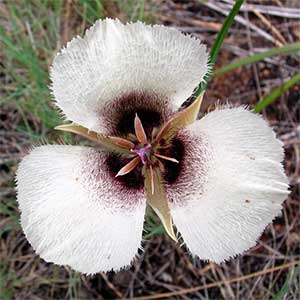Calochortus eurycarpus
Calochortus umpquaensis
big-pod mariposa, big-pod mariposa lily, white mariposa lily, wide-fruit mariposa lily
Umpqua mariposa-lily
not branching, straight, 1–5 dm.
not branching, straight, often scapelike, 2–3 dm, glabrous or glaucous.
basal persistent, subtended by inflorescence, 1–3 dm × 5–25 mm;
blade flat, tapering toward both ends, becoming involute.
basal solitary, clasping;
blade narrowly lanceolate, hairy, adaxially hispid, abaxially glabrous, sometimes glaucous. Inflorescences 1–several-flowered;
bracts 2, suboppo-site, narrowly lanceolate.
subumbellate, 1–5-flowered;
bracts 2 or more, narrowly lanceolate to linear, long-attenuate, unequal, 1–5 cm.
erect;
perianth open, campanulate;
sepals ovate to lanceolate, usually much shorter than petals, glabrous, apex acute to acuminate;
petals creamy white to lavender, with conspicuous median red-purple adaxial blotch, obovate, invested near gland with few long, flexuous hairs, base cuneate, apex rounded or acute;
glands triangular-lunate, slightly depressed, bordered proximally by comparatively narrow, deeply fringed membrane, distally often by narrower, crenate membranes, enclosed surface densely covered with long yellowish hairs, which, with membrane fringe, are often inconspicuously papillose;
filaments slightly longer than anthers;
anthers oblong, apex obtuse.
erect;
perianth open, campanulate;
sepals lanceolate-acuminate, ca. 2 cm;
petals white to cream, with dark purple-black, pentagonal to lunate blotch, broadly oblong to obovate, 3.5 cm, bearded, adaxial surface typically minutely papillose, margins erose;
glands transversely oblong-lunate, slightly depressed, with 0.7–1.4 mm-wide band of short dendritic hairs distally, hairs surrounded by lime-green coloration and purple striations;
anthers lanceolate, apex acuminate.
erect, 3-winged, ellipsoid-oblong.
nodding, 3–5.4 cm.
light beige.
2.8–3.5 mm, with inflated bulbous crest and hollow lateral ridge.
= 20.
= 20.
Calochortus eurycarpus
Calochortus umpquaensis
Of conservation concern.
Calochortus umpquaensis is known only from Watson and Ace Williams mountains on both sides of the Little River, Douglas County.
(Discussion copyrighted by Flora of North America; reprinted with permission.)


